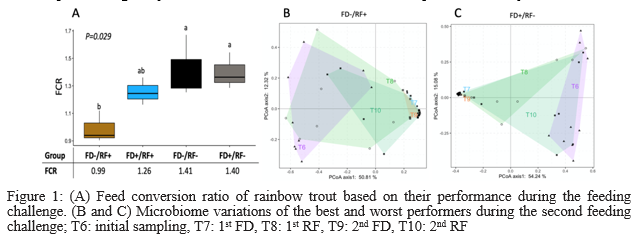GENETIC AND NUTRITIONAL APPROACHES TO ENHANCE THE EFFICIENCY OF SOYBEAN MEAL UTILIZATION IN RAINBOW TROUT
The USDA ARS and UofI have developed several rainbow trout (Oncorhynchus mykiss ) lines that show higher growth rates when fed an all-plant protein diet than non-selected lines of trout fed the plant protein diet or a fishmeal-based diet. So far, no commercial breeding programs has yet started to improve feed utilization efficiency in fish, mainly because of the difficulty in accurately measuring individual feed intake of fish reared in groups. Using these selected lines we proposed to test if feed conversion ratio (FCR) and body weight variations during successive periods of feed deprivation (FD) and re-feeding (RF) are correlated using a compensatory feeding regime . The goal of this study was to determine if indirect selection for the above traits could be used to develop alternative criteria to improve feed intake of the plant-based fed selected strain.
We began with 1600 fish (av. Int. wt. 30 g) from 12 families of the selected line, fed the plant protein diet (50% soy , protein: 41% and lipid: 20%). First, fish were tagged individually and reared in a common environment, t hey were then placed on feeding challenge regime for 4 months (one month each challenge either FD or RF), and performance were recorded . Thereafter, fish were separated into four groups (1331 fish) based on individual performance during FD and RF challenge study. FCR was recorded for 3 months in all four groups followed by measuring the stability of response to the FD and RF periods (2nd feeding challenge) which was the same as the 1st one. Out of 1331 fish, 143 fish exhibited a similar pattern of weight loss and gain, confirming the stability. As expected, the most efficient group was the FD-/RF+ (FCR=0.99) and the least efficient groups with FCR of ~1.4 were FD-/RF- and FD+/RF- (Figure1A) . Studying the gut microbiome of all four groups revealed that despite the variations dictated by FD and RF, the bacterial community of FD-/RF+ group (best performers) shows more stability than the FD+/RF- (worst performers) throughout the feeding challenges (Figure 1B and 1C) .
Conclusively, FCR improved more than 15 % in best group (FD+/RF-) compared to the FD-/RF+ group which means utilizing these fish selected for improved feed efficiency will reduce soybean consumption and greatly decrease the feed cost for sustainable aquafeed industry.
